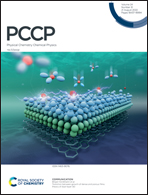Combined fragment-based machine learning force field with classical force field and its application in the NMR calculations of macromolecules in solutions†
Abstract
We have developed a combined fragment-based machine learning (ML) force field and molecular mechanics (MM) force field for simulating the structures of macromolecules in solutions, and then compute its NMR chemical shifts with the generalized energy-based fragmentation (GEBF) approach at the level of density functional theory (DFT). In this work, we first construct Gaussian approximation potential based on GEBF subsystems of macromolecules for MD simulations and then a GEBF-based neural network (GEBF-NN) with deep potential model for the studied macromolecule. Then, we develop a GEBF-NN/MM force field for macromolecules in solutions by combining the GEBF-NN force field for the solute molecule and ff14SB force field for solvent molecules. Using the GEBF-NN/MM MD simulation to generate snapshot structures of solute/solvent clusters, we then perform the NMR calculations with the GEBF approach at the DFT level to calculate NMR chemical shifts of the solute molecule. Taking a heptamer of oligopyridine-dicarboxamides in chloroform solution as an example, our results show that the GEBF-NN force field is quite accurate for this heptamer by comparing with the reference DFT results. For this heptamer in chloroform solution, both the GEBF-NN/MM and classical MD simulations could lead to helical structures from the same initial extended structure. The GEBF-DFT NMR results indicate that the GEBF-NN/MM force field could lead to more accurate NMR chemical shifts on hydrogen atoms by comparing with the experimental NMR results. Therefore, the GEBF-NN/MM force field could be employed for predicting more accurate dynamical behaviors than the classical force field for complex systems in solutions.

- This article is part of the themed collection: 2022 PCCP HOT Articles


 Please wait while we load your content...
Please wait while we load your content...